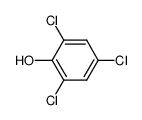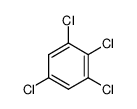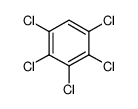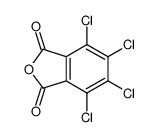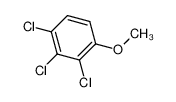| Product name | 1,2,3,4-tetrachlorobenzene |
|---|
| Product number | - |
|---|---|
| Other names | Benzene, 1,2,3,4-tetrachloro- |
| Identified uses | For industry use only. |
|---|---|
| Uses advised against | no data available |
| Company | MOLBASE (Shanghai) Biotechnology Co., Ltd. |
|---|---|
| Address | Floor 4 & 5, Building 12, No. 1001 North Qinzhou Road, Xuhui District, Shanghai, China |
| Telephone | +86(21)64956998 |
| Fax | +86(21)54365166 |
| Emergency phone number | +86-400-6021-666 |
|---|---|
| Service hours | Monday to Friday, 9am-5pm (Standard time zone: UTC/GMT +8 hours). |
Acute toxicity - Oral, Category 4
Hazardous to the aquatic environment, short-term (Acute) - Category Acute 1
Hazardous to the aquatic environment, long-term (Chronic) - Category Chronic 1
2.2 GHS label elements, including precautionary statements| Pictogram(s) |   |
|---|---|
| Signal word | Warning |
| Hazard statement(s) | H302 Harmful if swallowed H410 Very toxic to aquatic life with long lasting effects |
| Precautionary statement(s) | |
| Prevention | P264 Wash ... thoroughly after handling. P270 Do not eat, drink or smoke when using this product. P273 Avoid release to the environment. |
| Response | P301+P312 IF SWALLOWED: Call a POISON CENTER/doctor/…if you feel unwell. P330 Rinse mouth. P391 Collect spillage. |
| Storage | none |
| Disposal | P501 Dispose of contents/container to ... |
none
3.Composition/information on ingredients 3.1 Substances| Chemical name | Common names and synonyms | CAS number | EC number | Concentration |
|---|---|---|---|---|
| 1,2,3,4-tetrachlorobenzene | 1,2,3,4-tetrachlorobenzene | 634-66-2 | none | 100% |
Consult a physician. Show this safety data sheet to the doctor in attendance.
If inhaledIf breathed in, move person into fresh air. If not breathing, give artificial respiration. Consult a physician.
In case of skin contactWash off with soap and plenty of water. Consult a physician.
In case of eye contactRinse thoroughly with plenty of water for at least 15 minutes and consult a physician.
If swallowedNever give anything by mouth to an unconscious person. Rinse mouth with water. Consult a physician.
4.2 Most important symptoms/effects, acute and delayedACUTE/CHRONIC HAZARDS: This compound may cause irritation of the skin.
4.3 Indication of immediate medical attention and special treatment needed, if necessary Absorption, Distribution and ExcretionThree tetrachlorobenzene (TCB) congeners (1,2,3,4- 1,2,3,5- and 1,2,4,5-tetrachlorobenzene) were administered daily by gavage to pregnant Sprague-Dawley rats at levels of 50, 100, or 200 mg/kg from day 6-15 of gestation. Residues of all three congeners were found in maternal and fetal tissues but generally the amounts of the 1,2,4,5- isomer were about 100 times higher than the other two.
5.Fire-fighting measures 5.1 Extinguishing media Suitable extinguishing mediaFires involving this material should be controlled using a dry chemical, carbon dioxide or Halon extinguisher.
5.2 Specific hazards arising from the chemicalThis chemical is probably combustible.
5.3 Special protective actions for fire-fightersWear self-contained breathing apparatus for firefighting if necessary.
6.Accidental release measures 6.1 Personal precautions, protective equipment and emergency proceduresUse personal protective equipment. Avoid dust formation. Avoid breathing vapours, mist or gas. Ensure adequate ventilation. Evacuate personnel to safe areas. Avoid breathing dust. For personal protection see section 8.
6.2 Environmental precautionsPrevent further leakage or spillage if safe to do so. Do not let product enter drains. Discharge into the environment must be avoided.
6.3 Methods and materials for containment and cleaning upPick up and arrange disposal. Sweep up and shovel. Keep in suitable, closed containers for disposal.
7.Handling and storage 7.1 Precautions for safe handlingAvoid contact with skin and eyes. Avoid formation of dust and aerosols. Avoid exposure - obtain special instructions before use.Provide appropriate exhaust ventilation at places where dust is formed. For precautions see section 2.2.
7.2 Conditions for safe storage, including any incompatibilitiesStore in cool place. Keep container tightly closed in a dry and well-ventilated place.
8.Exposure controls/personal protection 8.1 Control parameters Occupational Exposure limit valuesno data available
Biological limit valuesno data available
8.2 Appropriate engineering controlsHandle in accordance with good industrial hygiene and safety practice. Wash hands before breaks and at the end of workday.
8.3 Individual protection measures, such as personal protective equipment (PPE) Eye/face protectionSafety glasses with side-shields conforming to EN166. Use equipment for eye protection tested and approved under appropriate government standards such as NIOSH (US) or EN 166(EU).
Skin protectionWear impervious clothing. The type of protective equipment must be selected according to the concentration and amount of the dangerous substance at the specific workplace. Handle with gloves. Gloves must be inspected prior to use. Use proper glove removal technique(without touching glove's outer surface) to avoid skin contact with this product. Dispose of contaminated gloves after use in accordance with applicable laws and good laboratory practices. Wash and dry hands. The selected protective gloves have to satisfy the specifications of EU Directive 89/686/EEC and the standard EN 374 derived from it.
Respiratory protectionWear dust mask when handling large quantities.
Thermal hazardsno data available
9.Physical and chemical properties| Physical state | WHITE CRYSTALLINE SOLID |
|---|---|
| Colour | Colorless needles |
| Odour | no data available |
| Melting point/ freezing point | 44-48ºC |
| Boiling point or initial boiling point and boiling range | 254ºC(761 torr) |
| Flammability | no data available |
| Lower and upper explosion limit / flammability limit | no data available |
| Flash point | 111.9ºC |
| Auto-ignition temperature | no data available |
| Decomposition temperature | no data available |
| pH | no data available |
| Kinematic viscosity | no data available |
| Solubility | less than 1 mg/mL at 21.11°C |
| Partition coefficient n-octanol/water (log value) | log Kow= 4.64 |
| Vapour pressure | 1 mm Hg at 68.5°C ; 5 mm Hg at 99.61°C; 760 mm Hg at 253.89°C |
| Density and/or relative density | 1,73 g/cm3 |
| Relative vapour density | no data available |
| Particle characteristics | no data available |
no data available
10.2 Chemical stabilityStable under recommended storage conditions.
10.3 Possibility of hazardous reactionsSimple aromatic halogenated organic compounds, such as 1,2,3,4-TETRACHLOROBENZENE, are very unreactive. Halogenated organics generally become less reactive as more of their hydrogen atoms are replaced with halogen atoms. Materials in this group may be incompatible with strong oxidizing and reducing agents. Also, they may be incompatible with many amines, nitrides, azo/diazo compounds, alkali metals, and epoxides.
10.4 Conditions to avoidno data available
10.5 Incompatible materialsIN MFR OF SODIUM SALT OF TRICHLOROPHENOL, SODIUM HYDROXIDE, METHYL ALCOHOL & TETRACHLOROBENZENE WERE HEATED. DURING HEATING PROCESS, PRESSURE SUDDENLY INCR RAPIDLY & EXPLOSION OCCURRED. /TETRACHLOROBENZENE/
10.6 Hazardous decomposition productsWhen heated to decomposition it emits toxic fumes of /hydrogen chloride/.
11.Toxicological information Acute toxicity- Oral: no data available
- Inhalation: no data available
- Dermal: no data available
no data available
Serious eye damage/irritationno data available
Respiratory or skin sensitizationno data available
Germ cell mutagenicityno data available
Carcinogenicityno data available
Reproductive toxicityno data available
STOT-single exposureno data available
STOT-repeated exposureno data available
Aspiration hazardno data available
12.Ecological information 12.1 Toxicity- Toxicity to fish: LC50 Pimephales promelas (fathead minnow) 1.1 mg/l 96 hr flow-through bioassay, wt 0.12 g, water hardness 45.5 mg/l CaCO3, temp: 25 +/- 1°C, pH 7.5, dissolved oxygen greater than 60% of saturation
- Toxicity to daphnia and other aquatic invertebrates: no data available
- Toxicity to algae: no data available
- Toxicity to microorganisms: no data available
A 0% theoretical BOD in sludge over a 4 week incubation period suggests that biodegradation of 1,2,3,4-tetrachlorobenzene will be slow(1). 1,2,3,4-Tetrachlorobenzene was biodegraded by an acclimated anaerobic sediment slurry obtained from the Tsurumi River, Japan(2). The first-order biodegradation rate constant was 0.038 days-1, corresponding to a half-life of about 18 days(2). The half-life of 1,2,3,4-tetrachlorobenzene in sewage sludge amended soil was 34.5 days(3). An enriched microbial culture derived from sediment of the Rhine River reductively dechlorinated 1,2,3,4-tetrachlorobenzene to 1,2,4-trichlorobenzene in 280 days after a lag period of 47 days(4).
12.3 Bioaccumulative potentialBCF values of 520 to 1,560 were measured in carp exposed to 10 ug/l of 1,2,3,4-tetrachlorobenzene during a 6 week incubation period and BCF values of 490 to 1,700 were measured in carp exposed to 1 ug/l of 1,2,3,4-tetrachlorobenzene during a 6 week incubation period(1). Mean log BCF values of 3.7-4.1 were measured for rainbow trout exposed to 1,2,3,4-tetrachlorobenzene(2). A mean log BCF value of 3.5 was measured in fathead minnows exposed to 1,2,3,4-tetrachlorobenzene for 2-120 hours(3). A mean BCF value of 5,200 was reported for rainbow trout exposed to low levels of 1,2,3,4-tetrachlorobenzene for 119 days and a mean BCF value of 12,000 was reported for rainbow trout exposed to high concns of 1,2,3,4-tetrachlorobenzene for 119 days(4). According to a classification scheme(5), these BCF values suggest that bioconcentration in aquatic organisms is high.
12.4 Mobility in soilA log Koc value of 3.8(1) was reported for 1,2,3,4-tetrachlorobenzene in soils and log Koc values of 3.5 to 3.8 were reported in sandy and clay loams(2). A log Koc value of 4.4 was reported for 1,2,3,4-tetrachlorobenzene in sediment obtained from Ise Bay, Japan(3) and a log Koc value of 4.7 was reported from sediment of Lake Oostvaardersplassen, Netherlands(4). According to a recommended classification scheme(5), these Koc values suggest that 1,2,3,4-tetrachlorobenzene has low mobility in soil.
12.5 Other adverse effectsno data available
13.Disposal considerations 13.1 Disposal methods ProductThe material can be disposed of by removal to a licensed chemical destruction plant or by controlled incineration with flue gas scrubbing. Do not contaminate water, foodstuffs, feed or seed by storage or disposal. Do not discharge to sewer systems.
Contaminated packagingContainers can be triply rinsed (or equivalent) and offered for recycling or reconditioning. Alternatively, the packaging can be punctured to make it unusable for other purposes and then be disposed of in a sanitary landfill. Controlled incineration with flue gas scrubbing is possible for combustible packaging materials.
14.Transport information 14.1 UN Number| ADR/RID: UN3077 | IMDG: UN3077 | IATA: UN3077 |
| ADR/RID: ENVIRONMENTALLY HAZARDOUS SUBSTANCE, SOLID, N.O.S. |
| IMDG: ENVIRONMENTALLY HAZARDOUS SUBSTANCE, SOLID, N.O.S. |
| IATA: ENVIRONMENTALLY HAZARDOUS SUBSTANCE, SOLID, N.O.S. |
| ADR/RID: unknown | IMDG: unknown | IATA: unknown |
| ADR/RID: unknown | IMDG: unknown | IATA: unknown |
| ADR/RID: yes | IMDG: yes | IATA: yes |
no data available
14.7 Transport in bulk according to Annex II of MARPOL 73/78 and the IBC Codeno data available
15.Regulatory information 15.1 Safety, health and environmental regulations specific for the product in question| Chemical name | Common names and synonyms | CAS number | EC number |
|---|---|---|---|
| 1,2,3,4-tetrachlorobenzene | 1,2,3,4-tetrachlorobenzene | 634-66-2 | none |
| European Inventory of Existing Commercial Chemical Substances (EINECS) | Listed. | ||
| EC Inventory | Listed. | ||
| United States Toxic Substances Control Act (TSCA) Inventory | Listed. | ||
| China Catalog of Hazardous chemicals 2015 | Listed. | ||
| New Zealand Inventory of Chemicals (NZIoC) | Not Listed. | ||
| Philippines Inventory of Chemicals and Chemical Substances (PICCS) | Listed. | ||
| Vietnam National Chemical Inventory | Listed. | ||
| Chinese Chemical Inventory of Existing Chemical Substances (China IECSC) | Listed. | ||
| Creation Date | Aug 15, 2017 |
|---|---|
| Revision Date | Aug 15, 2017 |
- CAS: Chemical Abstracts Service
- ADR: European Agreement concerning the International Carriage of Dangerous Goods by Road
- RID: Regulation concerning the International Carriage of Dangerous Goods by Rail
- IMDG: International Maritime Dangerous Goods
- IATA: International Air Transportation Association
- TWA: Time Weighted Average
- STEL: Short term exposure limit
- LC50: Lethal Concentration 50%
- LD50: Lethal Dose 50%
- EC50: Effective Concentration 50%
- IPCS - The International Chemical Safety Cards (ICSC), website: http://www.ilo.org/dyn/icsc/showcard.home
- HSDB - Hazardous Substances Data Bank, website: https://toxnet.nlm.nih.gov/newtoxnet/hsdb.htm
- IARC - International Agency for Research on Cancer, website: http://www.iarc.fr/
- eChemPortal - The Global Portal to Information on Chemical Substances by OECD, website: http://www.echemportal.org/echemportal/index?pageID=0&request_locale=en
- CAMEO Chemicals, website: http://cameochemicals.noaa.gov/search/simple
- ChemIDplus, website: http://chem.sis.nlm.nih.gov/chemidplus/chemidlite.jsp
- ERG - Emergency Response Guidebook by U.S. Department of Transportation, website: http://www.phmsa.dot.gov/hazmat/library/erg
- Germany GESTIS-database on hazard substance, website: http://www.dguv.de/ifa/gestis/gestis-stoffdatenbank/index-2.jsp
- ECHA - European Chemicals Agency, website: https://echa.europa.eu/






